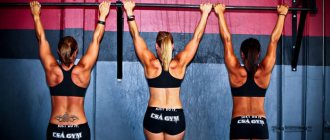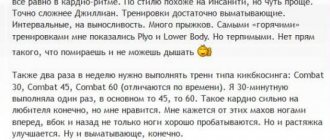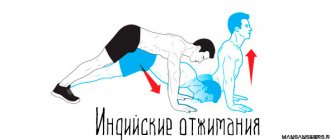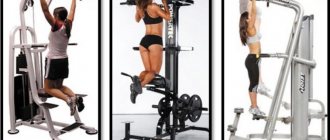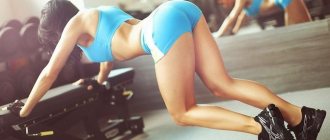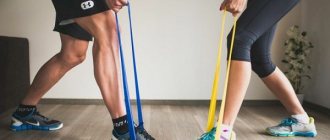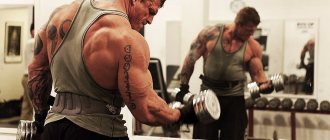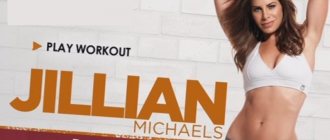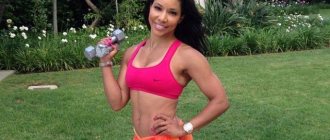Training on the horizontal bar and parallel bars is one of the most accessible and favorite among professional athletes and connoisseurs of an active, healthy lifestyle. With the help of these equipment you can give your muscles the required level of load, pump up your triceps, chest, biceps, back, hips, and legs.
Thanks to regular exercises according to the program for training on the horizontal bar and parallel bars, excess fat reserves will disappear, your mood will improve, and your physique will look like the figure of a real athlete . And the opportunity to exercise on the horizontal bar and parallel bars for free and at any time has turned training into an excellent alternative to the gym.
Tips for Beginners
To the inexperienced, it may seem that you can only do pull-ups on the horizontal bar, and do push-ups on the parallel bars machine. But in practice, everything is more exciting, because you can do a wide variety of exercises on these equipment. And load both individual muscle groups and the whole body.
First you need to master grips , which are also used in the workout program for training on the horizontal bar and uneven bars.
The main types of grips on the horizontal bar include:
- Straight (palms pointing away from you);
- Reverse (palms facing the face);
- Mixed (a combination of direct and reverse at the same time).
- Parallel (must be done simultaneously, on two apparatuses located close to each other, palms facing inward);
- Wide (distance between hands 0.5-0.8 meters);
- Medium (hands shoulder-width apart);
- Narrow (at the closest possible distance from each other).
When pulling yourself up with a wide grip, it is important to load your back muscles. With a narrow and medium grip, the muscles in the chest and arms are actively used.
Exercising on a thick crossbar increases the difficulty of the exercise and increases the expenditure of effort and energy.
Train all year round - buy equipment for your home:
Exercises for wall bars
Wall climbing is a simple exercise for children that helps develop coordination, endurance and comprehensive strengthening of body muscles.
“Hangs” on the arms help stretch the back muscles, improve blood circulation, and strengthen the muscles of the forearms and arms.
Hanging leg raises to the chest are an effective exercise for developing the abdominal muscles. “Corner” on the wall bars - a more simplified version of the exercise
“Corner” on uneven bars , in which part of the load is reduced by resting your back on the bars. When performing, you should keep your raised legs at right angles to your body.
Squats supported by a bar allow you to develop the strength of your buttock muscles.
Rules for training on horizontal bars and uneven bars
Before you begin your training program on the uneven bars and horizontal bar, it is important to do a good warm-up for the whole body . You can go for a run and stretch your muscles. Each exercise must be performed carefully and smoothly, correctly. This will reduce the likelihood of injury and increase the effectiveness of your workout.
Avoid sudden movements, they can cause harm.
At first , you need to train 3-4 times a week and alternate exercises on the uneven bars and horizontal bar with cardio exercises.
Two workouts should be “deload” to give the body the necessary rest and time to recover.
Exercises on the monkey bars
“Interceptions” are a basic exercise that is performed in several stages: grabbing the first bar with one hand, pulling up, hanging on a bent arm, and grabbing the next bar with the second hand. For beginners, short interceptions are recommended. Complicated variants of the exercise - transition to long interceptions with a grip from the side or in the opposite direction.
Imitation of climbing is an effective exercise in which an interception is performed with support from the legs. The task is complicated by changing the length of the interceptions and using different grip options.
Exercises for muscle growth
To improve body contours, it is necessary to combine training on the uneven bars and horizontal bar with lifting the barbell in the bench press. Once you can perform the exercises easily, you can increase the load by adding weight to the barbell. To do this, add a couple of kilograms, put weights on your belt and legs.
To build muscle well, you need to train regularly and according to a schedule.
To create a training program on the horizontal bar and parallel bars, decide how many times a week you will train. If you exercise 4 times a week, the first and second days of training should be intense . Dedicate the third day to rest. And then do it all over again.
First day
Push ups:
- from the floor with a medium grip;
- feet on a bench, medium grip;
- wide grip from the floor, feet on a high bench;
- on uneven bars.
Hanging on the bar: straight legs raised to the head.
Second day
Pull-ups:
- behind the head, wide grip;
- wide grip to chest;
- medium grip;
- narrow grip;
- parallel grip.
Hanging on the horizontal bar: straight legs rise to the head.
Repeat the exercises as much as your physical fitness allows. When the body's capabilities increase, you can repeat the load more , and the number of approaches needs to be increased for each exercise.
Four-time training on the horizontal bar and uneven bars differs from two-time training, because... there is no break in it . The first two days you need to work out 1 circle of the program, then repeat the circle. After which you need a break for one day (for recovery).
Standing bar push-up technique
We transfer the body weight in the starting position to our hands, straightening up completely. The pelvis, knees, head and shoulders should be strictly in line. Now we bend our elbows and lower ourselves so that our chest touches the bar. Then we rise until our arms are straight. The elbows look to the sides.
You need to move slowly at first, as this will allow you to control the position of your body. If you devote time to this, while doing fewer repetitions, you can effectively increase their number in the future.
You need to start doing push-ups from the bar at a higher height, exercising control over your entire body. Then you can lower the bar, and then other muscle groups will be trained better. Movements must be performed without jerking, without using the force of inertia. Do not contract your shoulder blades. Do not use your hands to spring.
Exercises for relief
For body definition, a specific system is suitable, designed for 4 workouts per week. Two days of training, a break of one day and again training for two days in a row. Then you can rest for two days. Each time you need to increase the number of repetitions and approaches .
First day
- pull-ups: wide grip, wide grip behind the head;
- push-ups: on parallel bars, wide grip from the floor;
- hang: raise straight legs to the head;
- press on uneven bars.
Second day
- push-ups from the floor, medium grip, and then from the floor, feet on the bench;
- lying on your back, raising both legs at the same time;
- twisting on the horizontal bar;
- hang on the bar, raise your legs to your head.
The third day
- pull-ups: on the bar, reverse grip;
- palms to face, narrow grip.
- push-ups: on parallel bars, from the floor with a medium grip.
- hanging on the horizontal bar, raising your knees and then on the uneven bars, raising straight legs.
Fourth day
- push-ups: from the floor and from the floor, feet on the bench;
- hanging with legs raised to a right angle;
- press on the floor;
- horizontal bar: twisting.
Dips[edit | edit code]
Main article:
Dips
Once you have no problem doing multiple push-ups with your feet on the ground, you'll be ready for the real thing. Bars are the classic triceps push-up. Just like pull-ups, push-ups are more difficult for women than men. These exercises are among the best for both sexes.
When doing dips, you need to bend forward. Your elbows should be slightly higher than your forearms with your shoulders facing forward. The degree of inclination can be varied, and this affects the final result of the exercise. The more you bend, the more intensely you train your chest muscles. The straighter you hold your body, the more intensely your triceps and core muscles work. However, getting into a position that is completely perpendicular to the ground is not recommended because it puts unnecessary stress on your shoulders. Well, unless, of course, you have exceptional strength.
It should be noted that the distance between the bars and their thickness affect the difficulty of the exercise. For beginners, it is better to use thinner bars located at a considerable distance from each other (about 50-60 cm), while narrow bars (when the bars are no further than 40-50 cm apart) make push-ups more difficult.
Author: Al Kavadlo
How to do push-ups correctly?
Parallel bars are an excellent exercise machine for the chest, arms and shoulders. And doing a dip program will work your abs, back, and legs . True, the level of load depends on the technique of performing the exercises.
When starting to master the horizontal bar and parallel bars exercise machines, it is important to keep your balance and not “dangle” . Otherwise, you risk getting sprains and injuries. Standing along the bars, push off the ground with your feet, then grab the bars with your straight arms. Stay straight. Jump off smoothly. You need to reach the uneven bars using your arms and shoulders .
Mass training on the horizontal bar and uneven bars! Pump up your arms and chest without exercise equipment.
It is important to do push-ups correctly . Bend your knees (to a right angle), then cross them (as shown in the photo above). This will add stability. Bend slightly forward, and as you exhale, bend your elbows to a right angle. Do not spread your arms to the sides; your elbows should be pressed as close to your body as possible.
As you exhale, straighten up. If you feel warmth in your triceps, you're doing everything right .
To work the pectoral muscles, go lower. But the angle at the elbow should be about 30 degrees. At first, it is better to refuse such a complication. And when the body finds it easy to do the initial version of the exercise, move on to the more complicated version.
The break between approaches should be up to 2 minutes.
On the crossbar, hangs, stops, lifts, flips, revolutions, swings, turns and dismounts are performed. They can be simple or very complex, amenable to mastery only by qualified gymnasts. These exercises have great potential for developing coordination of movements, muscle strength, flexibility, and resistance of the functions of the vestibular analyzer to action.
the importance of acceleration, orientation in space, emotional stability, determination and courage, accurate calculation and caution when performing complex exercises, for the formation of correct posture, and, consequently, the promotion of health.
In classes with schoolchildren, low, medium and high (height 255 cm from the surface of the mats) crossbars are used. At large physical education festivals, quite complex exercises are performed on crossbars up to 4 m high.
The main working part of the crossbar is the bar. It is a metal rod, relying on which gymnasts perform exercises, holding onto it with their hands with a grip from above and below; different, reverse and cross grips.
Exercises on the horizontal bar are performed at competitions by gymnasts of all levels of fitness - from beginners to international masters.
Vis
is the initial and intermediate element in the system of combination elements. It is performed by grasping the bar of the bar with four fingers on top and the thumb on the bottom. Hanging is characterized by sagging in the shoulder, sternoclavicular and hip joints under the influence of the weight of the body. Training begins with hanging on the top rail of the gymnastic wall with your face and back to it. There are several types of hangs.
Hanging on bent arms
characterized by their extreme bending at the elbow joints, the chin is higher than the bar of the crossbar. Performed with help and then independently.
Hanging bent over
performed from the front (hips touch the front surface of the crossbar bar), from the back (hips touch the back surface of the bar bar), legs apart left (right), on the knees. In this case, the gymnast’s body hangs upside down.
Hanging bent -
This is the position of the gymnast on the apparatus in which his body is maximally bent at the hip joints, his legs are between his arms, and his head is slightly tilted forward. Performed by force or swinging. Varieties of the bent over hang are the front bent and back bent hang.
Hanging from behind
It is performed from a hanging position, bent and bending, lowering the legs and pelvis down to the limit, slight flexion in the hip joints is allowed.
Insurance and assistance when performing hanging exercises are provided while standing on the side with one hand under the back, the other under the stomach or neck and pelvis.
Mixed hangs include: standing hang; hanging crouching; hanging lying down; hanging legs backwards; hanging lying sideways longitudinally and transversely; hanging on one and two legs; hanging on the right (left) outside.
Stops
on the crossbar are most often mixed, since the gymnast leans on it not only with his hands, but also with other parts of the body. The stops include: stop, back stop, crouching stop; emphasis - right (left) to the side, with feet resting on the crossbar, foot support apart from the right (left), the same outside; emphasis standing bent over, the same legs apart. The technique of their execution is simple, so they are studied using a holistic method, first on a low and then on a high crossbar. Simple stops include: stop with an angle and stop with the angle of the leg apart outside. These stops are connecting and can serve as a starting position for performing complex elements.
Lifting upside down
- strength exercise. To perform it, you need to bend your arms as much as possible and, bending at the hip joints, bring your straight legs to the crossbar, bringing your pelvis closer to the bar. Leaning on it with your hips, grab it with your hands and, straightening your arms, raise your shoulders, take a support position, keeping your legs from moving forward. Training begins on a low crossbar in the following sequence: with a push of one and a swing of the other, the exercise is performed from a hanging position (arms bent), the supporting leg is under the crossbar, the swing leg is pulled back. Swinging your legs up and over the bar, the pelvis is brought to the bar, the legs connect and create a rotational moment. As you turn over, the head and shoulders are pulled back, and the muscles of the back surface of the body are involved in the work to prevent the legs from moving under the crossbar (Fig. 208). After mastering the exercise in this way, they begin to study it with a push of two, and then with force. In each case, assistance is first provided, and then the exercise is performed independently. Insurance and assistance are provided under the legs, back and shoulder, and when going to point-blank range, support is provided by the legs. The technique for performing an inversion lift on a high crossbar with force is similar to performing it on a low crossbar.
The right lift is performed from a hanging position in a bent position. Extending your arms at the shoulder joints, head straight, take several (3-4) running steps until the body is almost fully extended at the hip joints. Then, with a swing of one and a push of the other, you must again sharply bend at the hip joints, bring both legs to the bar at the level of your toes, slightly spread them and bring your left (right) leg under the bar without bending it at the knee. With the beginning of the backswing, extension in the hip joints begins, the body's central mass approaches the support. The movements are completed by placing the right leg apart, the front surface of the left leg is held against the crossbar, the torso is bent, the head is straight (Fig. 209). To perform the run correctly, you need to run several times at a slow pace with complete sagging in the shoulder joints. The exercise is studied in the following sequence: a) hanging with legs bent apart (bar at toe level); b) from the hanging position, bending your legs apart, straighten up to the hanging position with your legs bent apart (performed with a gradual increase in the speed of extension); c) swinging while hanging bent over with help and independently; d) on the backswing from a hanging position, bending the hanging position with the legs bent apart; e) after two or three swings, lift up point-blank with the right (left) with help and independently. Insurance and assistance are provided while standing on the side under the back and behind the shin or foot.
This exercise can also be performed: from an angle hang, from a run-up, from a rest with the right hand after a fall, and from a rest position after swinging one; on a high bar from swinging. After the end of the forward swing, actively bend at the hip joints and, bringing your legs up to the bar, swing one and without a pause, begin swinging at the hip joints, connecting your legs, at the end of the extension, grab your hands with straight arms and go to point-blank range. Help is provided by standing on the side of the Leg that is not performing the swing; push under the pelvis, and at the end
while lifting, hold your leg to slow down excess movement of your shoulders.
Kip-up
performed on a low bar from a stop while standing, bent, from a run, hanging at an angle and after falling from a stand, as well as on a high bar from a swing. The last method of performing this element is most typical for gymnastic exercises with a sports orientation. After completing the forward swing, actively bend at the hip joints, pointing your feet towards the bar of the crossbar and with an active movement, sending your legs up and forward, straighten up, bringing your pelvis closer to the crossbar. At this moment, with the efforts of your hands, send your shoulders forward and grab your hands, fixing the position of the stop or performing a swing to perform the next element (Fig. 210). The exercise is studied first on a low or medium crossbar using leading exercises: a) imitation of leg movements using a gymnastic stick; b) hanging at an angle, resting your feet on the mat, bending your knees and bending, without moving your head back; c) after bending, quickly bring your straight legs to the crossbar (toes or middle of the shin); d) perform a kip-up with help; e) with the help of the teacher, perform a swing in a hanging position, bent in front, and when moving backward, perform a kip-up. Then they move to the high bar. The teacher, standing in front and to the left of the gymnast performing the hang, leaning with both hands in the area of the iliac bones, takes the student back from the balance position and holds him in this position. The gymnast bends at the hip joints, pointing the feet toward the line of projection of the bar onto the mats. After this, the teacher removes the support with his hands and gives the gymnast the opportunity to freely move forward to the balance position, i.e. to the initial hanging position. While going through this position, the gymnast must sharply straighten up in the
hip joints and move your arms back behind your head. Next - from a springboard standing 1 m from the crossbar, jump at a hanging angle and extension under the crossbar with the subsequent actions outlined above; from a small swing on the backswing, flexion at the hip joints, extension under the bar and performing an assisted kip-up. Insurance and assistance are provided while standing on the side under the legs and pelvis.
Turn from the support of the legs apart to the right side with a turn in a circle to the point of emphasis. When performing it, you need to transfer the weight of the body to the right and at the same time grab it with your right hand in an underhand grip, tilt your body a little to the right and back, leaning on your hip and arm, release your left hand and start turning to the right. The exercise begins with a sequential rotation of the head, left shoulder, torso and left leg, and ends with the position of the support (Fig. 211). They begin to learn the exercise on a gymnastics bench, where they reproduce the entire sequence of movements during a turn and the tension of the back muscles necessary to keep the legs from moving under the crossbar. After this, they move on to performing the exercise on a low bar, first with the support of the right foot or holding the right shoulder while standing on the side, then on their own. The study ends on a high bar.
Turn in a circle from the support of the legs apart with the right leg back to the support. The exercise begins with placing the left hand in an underhand grip, transferring the weight of the body onto it, turning the head, right shoulder and torso, and ends with placing the right hand on the bar, lifting the pelvis and swinging the left leg over the bar into emphasis. When learning the exercise, first perform a turn with an early position of the right hand, then from the support of the leg apart with the left outside perform a swing to the support position. Training begins on a low bar and ends on a high bar. Insurance and assistance are provided while standing on the side of the left hand, and if necessary, the practitioner is supported under the chest or legs.
A forward rotation with the right leg spread apart is performed with an underhand grip. In this position, you need to raise your pelvis and right leg forward, thereby removing the body's central mass from the support, stretch your shoulders up and forward, lean the front surface of your left leg on the crossbar, create the greatest possible moment of inertia and start turning. After passing the vertical, to increase the angular velocity, the pelvis gradually approaches the crossbar, moves up and forward and extends above the support, followed by the stomach, shoulders and head. When completing the rotation, to maintain balance, the legs must be spread as far apart as possible and the right leg should be placed in the position of support (Fig. 212). To master this exercise, it is recommended to do the following: a) step forward from a gymnastic bench, imitating the crossbar with a gymnastic stick; b) hanging legs apart, quickly joining the legs with the shoulders and head tilted forward; c) performing the first and second parts of the exercise separately with help; d) wiring throughout the exercise on a low bar; e) forward rotation with help and independently; f) execution on a high crossbar. Insurance and assistance are provided while standing from the side, grabbing the wrist with a reverse grip and supporting the back.
Turn back in support of the legs apart with the right (left)
has the same technical basis as the forward turn, but is performed in the opposite direction. To perform it, you need to raise your pelvis, move your left leg back, lean the back of your right leg on the bar, send your shoulders and head back and start turning. After passing the vertical position with your head down, you need to bring your legs together, bring your pelvis closer to the bar and thereby increase the speed of rotation. The second part of the exercise ends with an active movement of the head and shoulders back until the body reaches the position of supporting the legs apart. Sequence of learning: a) step back from the gymnastic bench, imitating the crossbar with a gymnastic stick; b) separate execution of the first and second parts of the exercise with the help
schew; c) wiring throughout the exercise on a low bar; d) performing the exercise as a whole with help and independently, first on a low and then on a high bar. Insurance and assistance are provided while standing from the side and in front with a reverse grip on the wrist and support under the chest.
Turn back at close range
performed after swinging back to a horizontal body position. As the body approaches the bar, the shoulders move back, the head leans slightly onto the chest, the hands press the hips to the bar, the legs move forward, bending slightly at the hip joints. In this position, the first part of the exercise is performed. Its second part ends with an active movement of the head and shoulders back, rotation of the hands and extension at the hip joints to the stop position (Fig. 213). Learning the turn begins with mastering a point-blank turn at a fast pace, and then the posture in which the turn is performed. To do this, after swinging, you need to return to point-blank range with a straight body position. This exercise is done several times until it is performed confidently. The second part of the rotation, when the head and torso pass the vertical line under the crossbar, requires special learning. Here it is important to include the muscles of the neck and back in time. To do this, while in an emphasis position, you need to bend, lowering your shoulders and head down, and then, turning your hands over the crossbar and engaging the neck and back muscles in active work, quickly straighten up and return to the starting position. The exercise is studied first on a low bar, and then on a high one. Help is provided by grasping the student’s forearm with one hand (the hand below the crossbar), and with the other assisting rotation; at the end of the rotation, you need to grab the student under the chest with one hand, and with the other keep your legs from moving under the crossbar.
Learning high bar exercises begins with learning the swing and simple dismounts.
Waving
characterized by the movement of the gymnast’s body relative to the crossbar over a certain amplitude. It can begin with bending, pulling, and jumping (Fig. 214).
Swinging curves
It begins with the fact that in a hanging position you need to raise your legs, then quickly lower them and take them back until they bend. After this, they need to be quickly brought to the crossbar at knee level and held in this position, waiting for the whole body to begin to move forward. After passing the front bending hang, intense extension begins in the hip and shoulder joints, which ends at the extreme point of the swing before the simple hanging pose.
Swinging pull-up
It is performed by vigorously pulling yourself up while hanging, bringing your legs to the bar at the level of your knees without straightening your arms (hanging in front on bent arms) and extension in the hip and shoulder joints. The actions in the final phase coincide with the actions when swinging with bends and are supplemented only by extension in the elbow joints.
Swinging from a jump (from a half swing).
From a standing position at a distance of a large step from the crossbar, you need to jump into a hanging position, thereby creating a small swing. On the backswing, after your body passes the vertical, you need to bend your arms and bend slightly. Then, after the forward swing begins, the legs rise forward and the body goes into a hanging position bent in front on bent arms. The final steps are the same as for the pull-up swing. Insurance and assistance are provided while standing at the side with your hands under the back of the thigh and back, and after extension in the hip joints - under the chest and back.
Arc swing.
From support, moving your shoulders back and sending your legs forward under the crossbar, bend slightly at the hip joints and, lowering your head to your chest, begin to move backwards in support.
In this exercise you need to see the toes of your feet from the very beginning. Once you reach a head-down position, gently move your arms back behind your head, keeping your body slightly bent. Subsequently, all actions coincide with the description of swinging with bends (Fig. 215).
Insurance and assistance are provided while standing on the side under the back of the thigh and back, and after extension in the hip joints - under the chest and back.
Dismounts
- they complete the combination, connections and execution of individual elements. The simplest of them are forward swing dismounts, backward swing dismounts and arc dismounts.
Jump forward.
On the forward swing, after passing the vertical, you need to bend your legs at the hip joints with a whip-like movement, accumulate the greatest possible moment of momentum with them, and at the end of the swing, leaning on your legs and hands on the crossbar (moving them back behind your head), raise the body's GCM as high as possible, bend over and release the bar and, maintaining a bent body position in flight, land (Fig. 216). When studying
For the dismount, it is recommended to use the following exercises: a) from the starting position, standing with your back to the gymnastic wall, a step away from it and holding the bar at head level, perform a bend, push off with your hands and move into an upright handstand; b) from hanging on the gymnastic wall, bending and unbending at the hip joints, dismounting with a forward swing; c) imitation of a dismount without releasing the crossbar with your hands; d) performing a dismount with help. Insurance and assistance are provided by standing on the side in front of the crossbar with one hand under the chest, the other under the back.
Backward swing dismount
It is performed with a whipping movement of the legs up and back, after the body passes the vertical position on the backswing and after actively pressing with the hands on the crossbar from above. At the end point of the swing, the arms are removed from the crossbar and pulled back, a bent body position in flight is assumed, followed by landing (Fig. 217). When training, it is recommended: a) to master swinging while hanging on the bar; b) learn to actively press with your hands on the crossbar, and at the end of the swing feel the moment of release of pressure; c) perform dismounts with a gradually increasing swing amplitude; d) increasing the amplitude of the swing, learn the dismount with the most active whipping movement of the legs up and back and energetic pressure with the hands on the crossbar and a push from it, with the body flying over the apparatus. Insurance and assistance are provided standing on the side under the crossbar, from the moment the student lifts off the crossbar, accompanying him with one hand under the chest, the other under the back, at the landing site to be on the side and behind.
Arc dismount.
Studying the arched dismount begins after mastering the arched swing and turning back in support. The first half of the dismount, up to the head down position, is similar to performing a back turn while in support. The second part consists of full extension in the hip joints, the head and arms are pulled back and the bar of the bar is lowered. The body position in flight is arched with the arms raised up and out (Fig. 218).
Arch dismount training: from a hanging standing jump, arc dismount with help; the same through a rope (its height can vary), stretched in front of the crossbar, parallel to the bar at a distance of 1 m from it; the same, but from point-blank range (with help).
Insurance and assistance are provided as with an arc swing. Only after extension in the hip joints - under the chest and back, accompanying the student until landing.
See also:
The hormone cortisol: normal levels in the blood and its functions in the body Water with grapefruit If your shoulders don’t grow It all starts with the strength of the Detox program
Parallel bars training program
From the first day of classes, the uneven bars training program will help you. You need to follow the program for three months . Then you can add new exercises, use horizontal bars and parallel bars for the press, or complicate already familiar exercises.
| Week no. | 1 | 2 | 3 | 4 | 5 | 6 | 7 | 8 | 9 | 10 | 11 | 12 | 13 | 14 | 15 | 16 | 17 | 18 | 19 | 20 |
| Approach 1 | 10 | 15 | 20 | 25 | 30 | 35 | 40 | 40 | 45 | 45 | 50 | 50 | 55 | 60 | 60 | 65 | 65 | 70 | 70 | 70 |
| Approach 2 | 5 | 15 | 20 | 25 | 30 | 30 | 35 | 40 | 40 | 45 | 45 | 50 | 50 | 55 | 60 | 60 | 60 | 60 | 65 | 65 |
| Approach 3 | 5 | 10 | 15 | 20 | 25 | 20 | 30 | 30 | 30 | 30 | 30 | 35 | 35 | 40 | 45 | 45 | 45 | 45 | 50 | 50 |
| Approach 4 | 3 | 5 | 15 | 15 | 18 | 20 | 20 | 20 | 20 | 25 | 25 | 25 | 25 | 25 | 30 | 35 | 35 | 35 | 35 | 40 |
| Approach 5 | 2 | 5 | 10 | 12 | 12 | 15 | 15 | 15 | 15 | 18 | 18 | 20 | 20 | 20 | 20 | 20 | 20 | 20 | 25 | 25 |
| Total | 25 | 50 | 80 | 97 | 115 | 125 | 140 | 145 | 150 | 163 | 168 | 180 | 185 | 195 | 210 | 220 | 220 | 225 | 235 | 240 |
Training program on the horizontal bar
A training program on the horizontal bar and uneven bars will allow you to quickly gain an athletic physique. Within 2-3 weeks the first positive changes will be noticeable.
To get the most benefits, be sure to give your body rest. Even if it seems like your body will do without a break, give yourself a day off. And to get the best result, use the training program on the horizontal bar and uneven bars. It will help you easily get into the right rhythm. As a result, you will achieve excellent success.
| Week no. | 1 | 2 | 3 | 4 | 5 | 6 | 7 | 8 | 9 | 10 | 11 | 12 | 13 | 14 | 15 | 16 | 17 | 18 | 19 | 20 |
| Approach 1 | 6 | 7 | 8 | 8 | 9 | 10 | 10 | 11 | 12 | 12 | 13 | 14 | 14 | 15 | 16 | 16 | 17 | 18 | 18 | 19 |
| Approach 2 | 5 | 6 | 6 | 7 | 7 | 7 | 8 | 8 | 8 | 9 | 9 | 9 | 10 | 10 | 10 | 11 | 11 | 11 | 12 | 12 |
| Approach 3 | 5 | 5 | 5 | 5 | 6 | 6 | 6 | 7 | 7 | 7 | 8 | 8 | 8 | 9 | 9 | 9 | 10 | 10 | 10 | 11 |
| Approach 4 | 4 | 4 | 5 | 5 | 5 | 6 | 6 | 6 | 7 | 7 | 7 | 8 | 8 | 8 | 9 | 9 | 9 | 10 | 10 | 10 |
| Approach 5 | 3 | 4 | 4 | 5 | 5 | 5 | 6 | 6 | 6 | 7 | 7 | 7 | 8 | 8 | 8 | 9 | 9 | 9 | 10 | 10 |
| Total | 23 | 26 | 28 | 30 | 32 | 34 | 36 | 38 | 40 | 42 | 44 | 46 | 48 | 50 | 52 | 54 | 56 | 58 | 60 | 60 |
The program on the horizontal bar and uneven bars is simple. Even if you have a low level of physical fitness, you can master the exercises in a couple of weeks. At first, the muscles will hurt a lot, so it is better to avoid heavy loads. But after a month of daily exercises, you will safely follow the training program on the horizontal bar and uneven bars.
